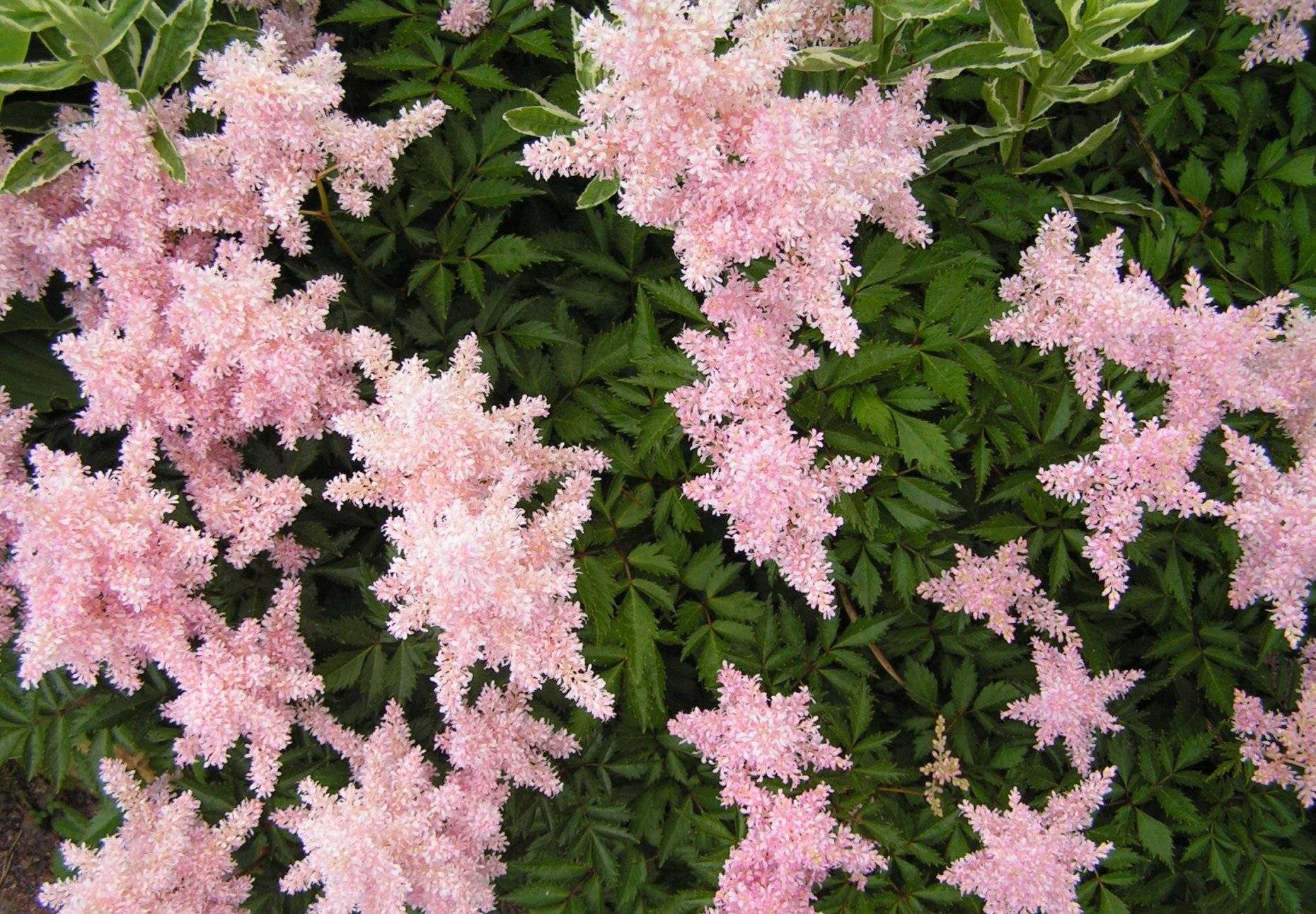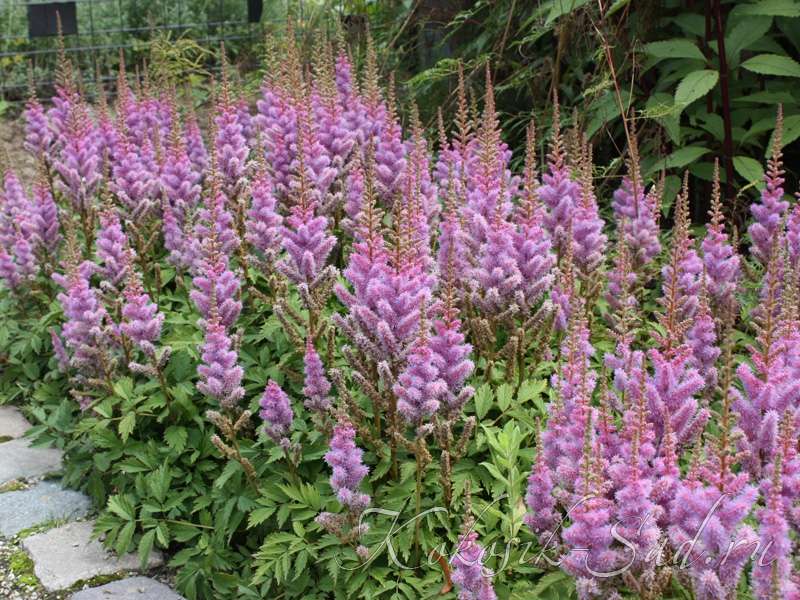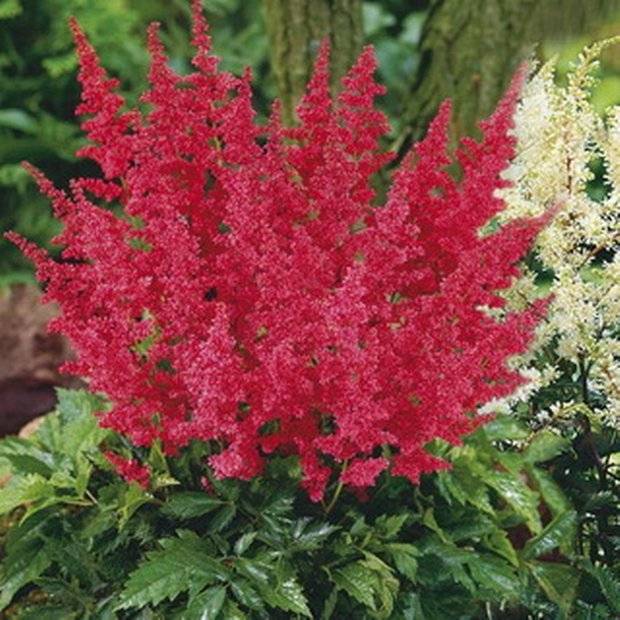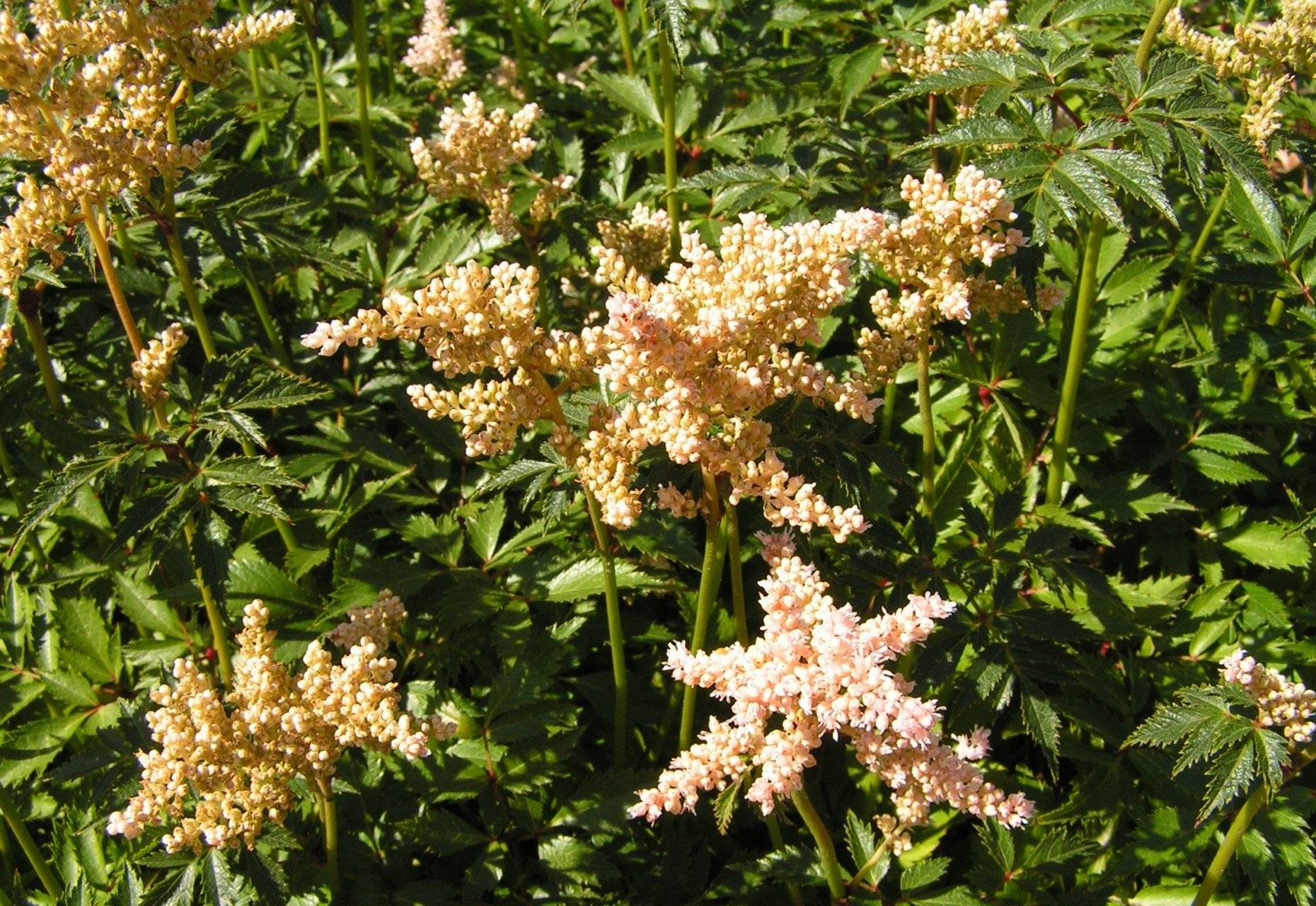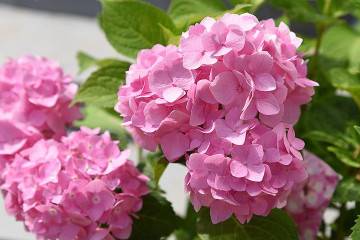Japanese astilba
Content:
- Shrub description
- Popular varieties and types of Japanese astilba
- Astilba white
- Astilba Sister Teresa
- Astilba Arends Amethyst
- Astilba Gloria Purpurea
- Astilba Washington
- Astilba Elizabeth Van Win
- Astilba curly
- Astilba Chocolate Shogun
- Astilba Color Flash Lime
- Astilba Red Sentinel
- Astilba Etna
- Astilba Brautschleier
- Astilba Arends Fanal
- Astilba Pumila
- Astilba Evra
- Astilba Arends America
- Astilba Japanese Red Sentinel
- Astilba Japanese Montgomery
- Astilba Japanese Peach Blossom
- Astilba Japanese Mainz
- Astilba Japanese Europe
- Astilba Japanese Bonn
Numerous species and varieties of Japanese Astilba have been obtained as a result of the work of breeders around the world. Resistant varieties were bred, on the basis of which new hybrids were created. As a result of the work carried out, species and varieties have been created that are admired for their beauty and have found application in garden and landscape design, as well as in drawing up beautiful bouquets.
Shrub description
This plant belongs to the genus Saxifrage. More than 200 varieties of this perennial are known. This herb is used for outdoor cultivation. Its height reaches 80 cm. Different types of Japanese astilba are united by the fact that they have dense fleshy leaves covered with a beautiful pattern.
Features and appearance
In astilba, according to the description, the flowering period lasts a long time - from early June to mid-September. Its flowers are collected in panicles with a length of 10 to 50 cm. They have a pleasant scent that resembles the scent of bird cherry.
When flowering ends, small seed pods are formed. In winter, the upper part of the bush completely dies off, only the roots survive until spring. In early spring, a new full-fledged shrub grows from them. It begins its development with small buds on the roots.
Planting and caring for this plant is not particularly difficult.
Popular varieties and types of Japanese astilba
This plant has a large number of species and varieties. It grows wild in East Asia, but today it is distributed throughout the world. Further, it is described in detail about the most famous types and varieties of Japanese astilba.
Astilba white
Various varieties can please with white inflorescences. Their homeland is East Asia. It grows almost all over the world: in Europe, North America, Russia and Japan. The height of the bushes can vary greatly. The tallest varieties can reach 2 m. Bushes of dwarf varieties can grow up to 10 cm. The variety has a lush flowering that lasts almost all summer.
Astilba Sister Teresa
It is a dense compact shrub up to 70 cm high. The leaf plates are dark green with a glossy surface. They are divided into two or three parts. The buds are collected in openwork diamond-shaped inflorescences 30 cm long, pale pink in color. The flowers have a delicate and pleasant aroma.
Flowering occurs within two months: it begins in June and lasts until the end of July. The variety prefers to grow in shaded areas, slightly acidic and loose loam, however, it is undemanding to the soil and grows well in various conditions.
This variety is used in garden design for its flowers and beautiful foliage.
Astilba Arends Amethyst
This astilba has more than 40 varieties. Their distinctive features are dense foliage and a spherical or conical shape of the bushes.Flowers can be of different colors, from white to dark purple. The flowering period is 40 days.
The species reaches a height of 1 m. Light green leaves grow on strong stems. Inflorescences have a delicate light lilac color.
Astilba Gloria Purpurea
She has bright pink inflorescences. This bush has a height of 70 cm. Rhombic flowers look voluminous and thus differ from other varieties. The bush grows densely, which is why Gloria Purpurea is often used to form hedges. This species has a short flowering period.
Astilba Washington
The bush grows up to 30 cm, but the peduncle can rise above it by another 25-30 cm. The foliage has a bright green color and an openwork shape. Flowering begins in July.
Astilba Elizabeth Van Win
This variety grows up to 60 cm. It grows well in shaded areas. In spring, the leaves are red, their edges are fringed. In summer, the leaf plates turn green. The inflorescences have a purple hue. Flowering begins in mid-July and ends in early August.
Astilba curly
This plant is miniature in size, its height does not exceed 20 cm. Despite this feature, the shrub is lush. The diameter of the plant is usually 25 cm.
This astilba has small flowers of pink or cream color, collected in panicles. The carved leaves look delicate and somewhat like green snowflakes.
Flowering occurs from early July to late August. Depending on the weather, it can continue even until the end of September.
Astilba Chocolate Shogun
This variety is one of the most famous. It won a prize at the Dutch Plantarium exhibition in 2013. This shrub attracts attention with its dark glossy leaves. Their brown-burgundy color persists throughout the growing season.
The height of the bush is 35 cm. Its maroon foliage is beautifully combined with creamy pink inflorescences. The length of the peduncles is 60 cm. Flowering begins in July and lasts until the end of August.
Astilba Color Flash Lime
This astilbe is a medium layer, the height of the bush reaches 65 cm. The peculiarity of this plant is that the leaves retain the same color as they grow. In the spring they are lemon-colored. Then a cream or dark green color appears at the edges of the leaf plates, which gradually paints over the entire surface.
The inflorescences are pale pink in color and paniculate in shape. The variety begins to bloom relatively late, in early August.
Astilba Red Sentinel
The flower is similar in appearance to the Montgomery Astilba variety, but grows 15 cm lower. It was bred by Dutch breeders. Its leaf plates are capable of changing color during the spring-autumn period. When the spring sun appears, they are red-brown, and then gradually turn green. On the leaf axis and peduncles, the color is green with a slight brown tint.
Astilba Etna
This shrub is shade tolerant. The fluffy red buds blend beautifully with the dark green foliage. The leaves are feathery and lacy, like a fern.
In early spring, the leaf plates are painted in a bronze tint. Gradually they acquire a green color.
The shrub prefers shaded areas and soil types with medium moisture. Too much shading will result in poor flowering.
This variety is a medium-sized, spreading shrub (45-60 cm high and 60-90 cm wide). The length of the inflorescences reaches 30 cm.
Flowering occurs throughout the summer and begins in April. Frost resistance allows to withstand winter frosts without losses, not exceeding -34 ° С.
Astilba Brautschleier
The height of the bush is 80 cm.Deciduous plates have an attractive brownish green color. Loose whitish-yellow inflorescences of drooping shape. Their length is 30 cm. Flowers appear in mid-July and continue to bloom until the end of summer.
Astilba Arends Fanal
The height of the bush is 60 cm. The shoots are strong and straight. The leaf plates have jagged edges. In spring, they have a brown hue, then by summer they change color to a rich green.
The petioles and stems of the shrub are reddish in color. Raspberry inflorescences have a paniculate shape and a length of 20 cm.
The beginning of the appearance of flowers is in June or July. They continue to appear for 20 days.
The plant grows well in high temperature and humidity conditions. If the summers are dry or cold, then flowering may begin in August. Inflorescences do not fade for a long time and do not lose their decorative appearance.
Astilba Pumila
It is a small ground cover plant. The height of the shrub is only 35 cm. When grown in the garden, it quickly fills the space allotted to it.
Astilba Pumila has beautiful leafy rosettes. The flowers are pink with lilac pubescence and are collected in elongated panicle inflorescences. They have a delicate and pleasant aroma. Flowering in this variety is later, it begins in August and lasts until the end of November.
The shrub grows well both in shade and in bright sunlight. He loves moist soil types, but is hardy in relation to a lack of moisture.
Astilba Evra
This bush has a cushion-shaped crown. The maximum height that this herbaceous perennial reaches is 40 cm. The leaf plates have a dissected shape, their surface is bright green in color. Flowering time from July to late August. Inflorescences of medium density with pale pink flowers of a beautiful diamond shape.
The shrub is used for curbs and can be grown for cutting.
Astilba Arends America
It is a compact shrub that can grow up to 70 cm. Inflorescences of pink-purple flowers are rhombic in shape. Flowers appear in early July and continue to open for two weeks. It grows well in soil that has high moisture content.
In landscape design, this variety is used to decorate shaded areas.
Astilba Japanese Red Sentinel
Such a bush does not need special care. It is able to grow without transplant for many years. At the same time, it does not lose its decorative appearance. This shrub is relatively tall, it grows up to 90 cm. If the plant is well watered and fertilized, it can grow even more.
The shrub blooms from June to August. The inflorescences have a carmine-red hue. Their length is 40 cm. The inflorescences have a diamond-shaped shape and medium density. Cirrus leaves are mostly green with a dark tinge.
This variety is characterized by high frost resistance.
Astilba Japanese Montgomery
This variety is hybrid. It is a widespread bush. The surface of the pinnate leaf plates is glossy. They are green-brown in color. The length of the leaves is 40 cm. The beginning of flowering is in May, it lasts until the end of August. At this time, brushes up to 17 cm long appear.
The diameter of individual flowers is 10 mm. The buds have a color from brown to dark red. The shape of the petal is such that their tips are narrowed.
The height of the bushes is 50-80 cm.
Astilba Japanese Peach Blossom
It is one of the most common hybrid varieties of astilba. The bushes grow up to 80 cm. It is a sprawling plant, its width is 70 cm. The leaves of this variety consist of two colors: the middle is dark green, and the edges are brown.
Astilba Japanese Peach Blossom blooms for a very short time. This period begins in July and lasts for two weeks. Inflorescences are pale lilac or pink. They have a paniculate shape and a length not exceeding 15 cm. When the flowering ends, boxes with seeds are formed instead of buds.
Astilba Japanese Mainz
In this variety, the flowers have a purple-pink hue. Inflorescences reach 30 cm. They are dense and fluffy paniculate in shape. This perennial plant prefers to grow in slightly shaded areas. The height of the bushes is 50-70 cm.
Astilba Japanese Europe
Astilbe Japonica Europa has tripartite leaf plates with a fern color. The beautiful inflorescences are diamond-shaped and have a delicate pastel color, they reach up to 15 cm. Although they look lush and dense, there is no aroma. The bud set takes place in mid-May.
If pruned in August, the bush will retain its shape until the end of autumn. The plant is able to easily adapt to conditions of excess moisture and bright lighting.
Astilba Japanese Bonn
This perennial shrub has deep red or pink flowers. The plant loves fertile and loose soil. It grows up to 70 cm.
In bright sunlight in hot weather, the bush may wither. He feels comfortable if he is dropped off next to a pond. The inflorescences of this variety have a conical shape.
A flower grower can choose from a large number of species and varieties of Japanese astilba, those that suit his tastes. The combination of an exquisite look and undemanding care leads to the fact that the popularity of this shrub continues to grow.
